1950s Bubble & Miniature Cars.
This page presents a set of 25 cards that must have been issued in the 1950s, titled "Miniature Cars & Scooters", that was issued by Ewbanks Limited, of Pontefract in the UK. The majority of the cards portray various tiny cars from across the world, including bubble cars, 3 wheelers and also a trio of scooters for good measure. The colours are still really clear, and the cards are all in excellent condition. Along with each card, I'll include the brief description of each vehicle that is given on the back of each card.
All 25 cards featuring bubblecars and scooters:
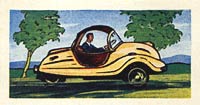 |
1. Avolette, France.
A plastic bodied three-wheeler, manufactured in France. It is available with two alternative power units, both of Lambretta. The 125cc develops approximately 45mph, the 150cc develops almost 55mph.
|
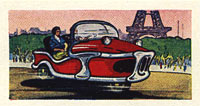 |
2. Microcar, France.
This is a prototype three-wheeler, constructed of aircraft style laminated plastic. It has pneumatic cushioning and, like the Bond, its power-unit is fitted to its single front wheel.
|
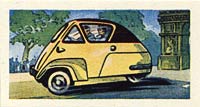 |
3. Velam (Isetta), France.
A French built version of the famous Italian body. This model was fully silenced in 1958. Powered by a 236cc engine, it is capable of speeds in excess of 50mph.
|
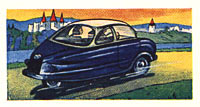 |
4. Fuldamobil, Germany.
The makers of the Fulda-mobil, who were first to construct mini-cars after the war, presented this model in 1957. It is constructed of plastic, powered by a 191cc unit and carries two adults.
|
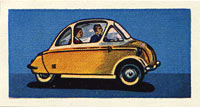 |
5. Heinkel (Kabine), Germany.
The 'Heinkel', the young child of a famous aircraft firm, began life with three wheels but has now grown a fourth. Its 4 stroke, 204cc OHV engine gives a maximum speed of 55mph and it cruises at 40mph with consumption of 70/80mpg.
(A scan of my Heinkel handbook features here.)
|
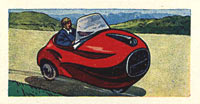 |
6. Opelit Mopetta, Germany.
This 'Brutsch' prototype is manufactured by the mammoth firm of Opel. A three-wheeler with single front wheel, plastic construction and mini-motor of 50cc, developing 25/30mph.
|
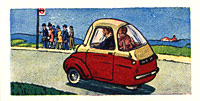 |
7. Scootacar, Britain.
The stubby Hunslet 'Scootacar' styled with two front wheels and single rear, seats two tandemwise. Powered by a 197cc unit, it has a top speed in excess of 45mph with low fuel consumption.
|
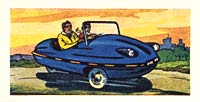 |
8. Tourette, Britain.
Introduced by the English branch of the German firm Progress, this three-wheeler resembles the design of the 'Brutsch'. It has a plastic body and is powered by a 197cc engine. Top speed about 45mph.
|
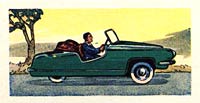 |
9. Bambino, Holland.
Of Dutch manufacture, this three-wheeled carriage has bodywork of plastic construction. A bench style two seater, of pleasing appearance, it is powered by a 200cc engine capable of over 55mph.
|
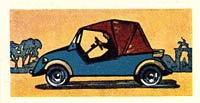 |
10. Voisin, Franco-Spanish.
This four-wheeler of French design is manufactured in Spain, at a quantity exceeding 300 per month. Motored by a 197cc engine, it has a speed in excess of 45mph. Seating for two, luggage space and fold-down hood.
|
 |
11. David, Spain.
A three-wheeler, obtainable as either saloon type or utility style vehicle. The engine, placed above the front wheel, develops 10hp at 4000 revs and gives a top speed of approximately 50mph.
|
 |
12. Phoenix, Britain.
The four-wheeler mini-car is of unusual shape. It is semi-panoramic, and entrance is gained by the centre section opening from the left side. Powered by a 197cc Villiers engine it has a top speed of 45mph.
|
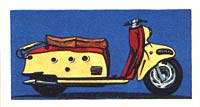 |
13. Maicoletta scooter, Italy.
A German production with a power unit of 277cc, which can lay a convincing claim to being the 'cream of scooters'. The machine cruises at between 55 and 60 miles per hour on a fuel consumption of about 70mpg. Has a well lit eight-day clock on the dashboard amongst many other refinements.
|
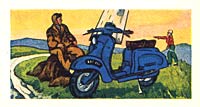 |
14. Lambretta scooter, Italy.
An extremely popular Italian scooter made in Milan in one of the most uptodate works. It is also made under licence in Britain, France and Germany. This machine usually has a 150cc two stroke engine, though a 175cc model will appear in England shortly.
|
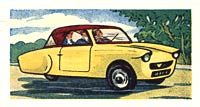 |
15. Coronet, Britain.
This relative newcomer to the mini-car market is styled after the predominant pre-war manner, ie two front and one rear wheel. It has sleek lines and powered by a 328cc Excelsior unit and gives speeds up to 65mph.
|
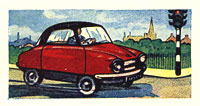 |
16. Frisky, Britain.
The 'Frisky' made its debut in March, 1957. It is a fixed-head coupe, with gullswing pattern doors. Powered by a 325cc Mercedes Benz 2 cyl. two stroke unit, it has a top speed of over 55mph and seats two adults and three children.
|
 |
17. Gordon, Britain.
The 'Gordon' is arranged Bond-wise, that is single front wheel and twin rear. Already established, it was slightly improved in 1957 with its 197cc engine and single door on the driver's side. Top speed above 45mph.
|
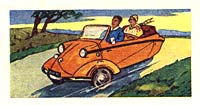 |
18. Messerschmitt Roadster, Germany.
The 'Roadster' offspring of another famous firm, is the three-wheel version. It has an air-cooled 191cc engine fitted in the rear, capable of approximately 65mph. Seats two and one child (small), tandemwise.
|
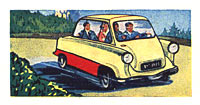 |
19. Zundapp (Janus), Germany.
This four-wheeler, four-seater has a centrally positioned engine of 248cc, capable of 50mph. It has a front and rear door, and production began in the summer of 1957.
|
 |
20. AC Petite, Britain.
The makers of the 'Petite' are the only tri-car manufacturers in business who started in Edwardian days. This smart little vehicle is powered by a 350cc Villiers single and has room for two adults and a child.
|
 |
21. Berkeley, Britain.
Designed by Laurence Bond, the 'Berkeley' has the appearance of a scale-size Italian sports car. With the 3 cylinder engine it is capable of speeds of 85mph and long distance endurance of over 50mph.
|
 |
22. ATOM, Britain.
One variant of the 'ATOM' is powered by a 322cc Anzani two-stroke twin engine and is capable of over 60mph. When fitted with a 650cc BSA twin, is a likely contender for fastest of the small.
|
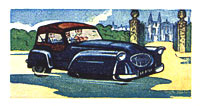 |
23. Bond Mark D, Britain.
A descendant of the most popular three-wheelers, the Mark D with single front wheel driven by a 197cc single-cylinder two stroke engine, it has a top speed of + 50mph and a consumption of 75mpg.
|
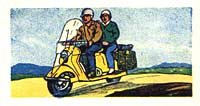 |
24. N.S.U. Prima, Britain.
A British machine usually made in three models. 1. NSU Prima Five Star 2. Prima 150cc 3. Quickly moped.
All of them finely made machines with first-class road qualities and performance. The smaller model, 'Quickly Moped', is exceptionally low in fuel consumption.
|
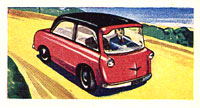 |
25. SMYK, Poland.
This Polish four-wheeled mini-car is very western in detail. Entrance is from the front, which opens from the left. Top speed is in the region of 50mph.
|
So thats it, the full set of 25 cigarette (or bubble gum?) cards, issued in the late 1950s, featuring various bubble- and micro-cars from across the world. The advent of proper small cars from the mass motor manufacturers would sound the death-knell for most microcar manufacturers, although Reliant, who don't feature here, would continue making fibreglass 3 wheelers for decades afterwards.
There was a great selection of preserved bubble cars at the 2006 Goodwood Revival, photographs of which can be found on the '06 Revival page. A screensaver featuring this type of car can be downloaded in the screensaver section.
Return to the main cigarette & collectors cards page.
|




